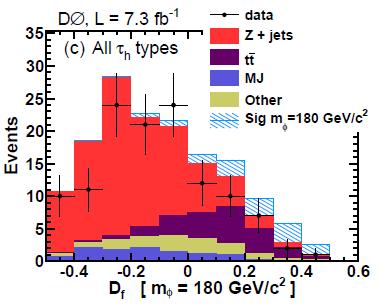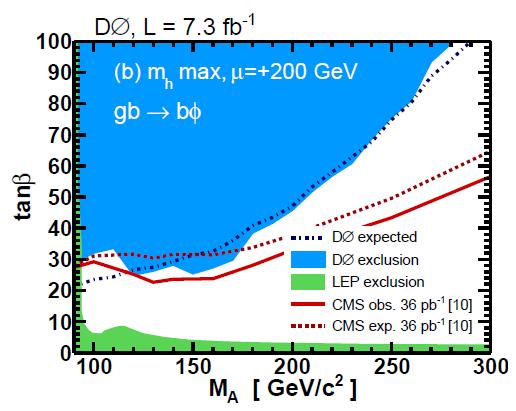Now DZERO throws no less than 7.3 inverse femtobarns of collisions at this important search. I guess this is the swan song for this particular analysis at the Tevatron, because the LHC experiments have already surpassed the sensitivity of their American competitors, with one two-hundredth (!) of the available statistics.
 But let me not get ahead of myself. Before I show the result, let me first discuss one meaningful figure from the article, showing the output of a global likelihood discriminant capable of nicely distinguish the decays of Higgs bosons to tau lepton pairs from all the concurring backgrounds. The figure on the right considers the case of a Higgs mass of 180 GeV, where the discrimination from Z decays (in red) is easy but the one from top decays (in purple) is harder. As you can see, a MSSM signal (for higgs mass of 180 GeV, shown in hatched light blue) would appear as a significant enhancement at high values of the discriminant D_f. This particular value of parameter space points is in fact excluded by the DZERO analysis; it refers to a value close to the boundary of the DZERO sensitivity curve (tan(beta)=40).
But let me not get ahead of myself. Before I show the result, let me first discuss one meaningful figure from the article, showing the output of a global likelihood discriminant capable of nicely distinguish the decays of Higgs bosons to tau lepton pairs from all the concurring backgrounds. The figure on the right considers the case of a Higgs mass of 180 GeV, where the discrimination from Z decays (in red) is easy but the one from top decays (in purple) is harder. As you can see, a MSSM signal (for higgs mass of 180 GeV, shown in hatched light blue) would appear as a significant enhancement at high values of the discriminant D_f. This particular value of parameter space points is in fact excluded by the DZERO analysis; it refers to a value close to the boundary of the DZERO sensitivity curve (tan(beta)=40).And now let us look at the results, shown in the graph below. The figure describes the relevant region of the MSSM parameter space (in a particular choice of some of the additional parameters, a configuration called "m_h max" which grants the maximum possible value to the lowest-mass neutral scalar) as a function of two crucial parameters: the value of tan(beta) and the mass of the CP-odd A boson.

In the graph you can see the region excluded by the new DZERO search in blue: the region which the DZERO data disfavors is the one at high tan(beta), where the coupling of the Higgs to down-type fermions would have allowed large production rates and decays to tau pairs. As you notice, the limit resulting from the search performed by CMS with just 36 inverse femtobarns (duly reported in the figure with a dashed red line) is more stringent, except in a small region for intermediate Higgs masses.
If one wished to argue more in detail about the sensitivity of the two experiments, one should in truth take the dashed curves, which show the expected limits (i.e., the median range of the exclusion limit that the experiments would expect to set with the available data and the analyses used). In this case one could still argue that at low mass the DZERO search is still superior to the CMS one; but of course, given that the CERN experiments are already sitting on thirty times more data than that reported in the graph, there is no question that this is now exclusively a LHC business. I look forward to the next ATLAS and CMS results for summer conferences, where the breathing space for the MSSM in the Higgs sector is going to become really uncomfortable. Of course: the MSSM is a beautiful, wrong construct, if you ask me.




Comments